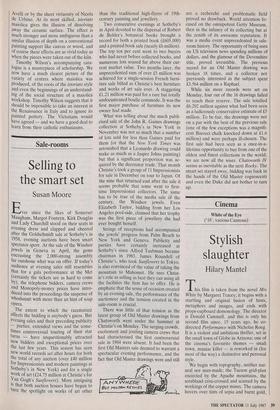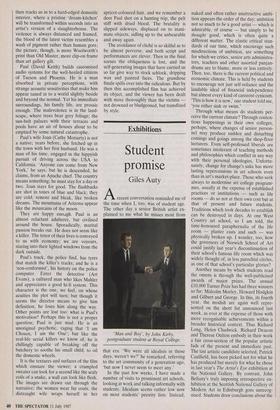Cinema
White of the Eye ('18', various Cannons)
Stylish slaughter
Hilary Mantel
This film is taken from the novel Mrs White by Margaret Tracey; it begins with a startling and original fusion of hints, metaphors and images, and ends with props-cupboard demonology. The director is Donald Cammell, and this is only his second film since, 15 years ago, he co- directed Performance with Nicholas Roeg. It is a violent and ambitious thriller, set in the small town of Globe in Arizona; one of the cinema's favourite themes — small town, maniac killer — is reworked in (for most of the way) a distinctive and personal style.
We begin with topography, neither nat- ural nor man-made; the Tucson grid-plan encircled by the Apache mountains, the scrubland criss-crossed and scarred by the workings of the copper mines. The camera hovers over tints of sepia and burnt gold, then tracks us in to a hard-edged domestic interior, where a pristine 'dream-kitchen' will be transformed within seconds into an artist's version of a slaughterhouse. The violence is always distanced and framed, the blood of the latest victim resembles a wash of pigment rather than human gore; the picture, though, is more Woolworth's print than Old Master, more clip-on frame than art gallery gilt.
Paul (David Keith) builds customised audio systems for the well-heeled citizens of Tucson and Phoenix. He is a man absorbed in private perceptions, with strange acoustic sensitivities that make him appear tuned in to a world slightly beside and beyond the normal. Yet his immediate surroundings, his family life, are prosaic enough. The malevolence is in the land- scape, where trees bear grey foliage; the sun-belt palaces with their terraces and pools have an air of houses about to be emptied by some natural catastrophe.
Paul's wife Joan (Cathy Moriarty) is not a native; years before, she fetched up in the town with her first husband. He was a man of his time, engaged in the hippyish pursuit of driving across the USA to California. 'Anyone can come from New York,' he says, but he is descended, he claims, from an Apache chief. The country means something; he must stay for a day or two. Joan stays for good. The flashbacks are shot in tones of blue and black; they are cold, remote and bleak, like broken dreams. The mountains of Arizona appear like the mountains of the moon.
They are happy enough. Paul is an almost reluctant adulterer, but civilised around the house. Sporadically, marital passion breaks out. He does not seem like a killer. The tenor of their lives is conveyed to us with economy; we are voyeurs, staring into their lighted windows from the dark outside.
Paul's truck, the police find, has tyres that match the killer's tracks; and he is a 'non-conformist', his history on the police computer. Enter the detective (Art Evans), a cultured man who likes Mahler and appreciates a good hi-fi system. This character is the one, we feel, on whose acuities the plot will turn; but though it seems the director means to give him definition, he loses him along the way.
Other points are lost too: what is Paul's motivation? Perhaps this is not a proper question; Paul is just mad. He is an unoriginal psychotic, raging that 'I am Chosen, I am the One'; but like the real-life serial killers we know of, he is chillingly capable of breaking off the butchery to soothe his small child, to oil the domestic wheels.
It is the textures and surfaces of the film which ensnare the viewer; a crumpled sweater can look for a second like the scaly coils of a snake, a wall can look like flesh. The images are drawn out through the narrative; the women wear fur coats, the distraught wife wraps herself in her apricot-coloured hair, and we remember a deer Paul shot on a hunting trip, the pelt stiff with dried blood. The brutality is slipped sideways, displaced on to inani- mate objects, sidling up to the unbearable and away again.
The avoidance of cliché is so skilful as to be almost perverse, and both script and performances are clever. Then in the final scenes the obliqueness is lost, and the self-generating images that have carried us so far give way to stock schlock, dripping wax and painted faces. The grandiose finale spills over into the ridiculous. But by then this accomplished film has achieved its object, and the viewer has been dealt with more thoroughly than the victims — not drowned or bludgeoned, but transfixed by style.



















































 Previous page
Previous page